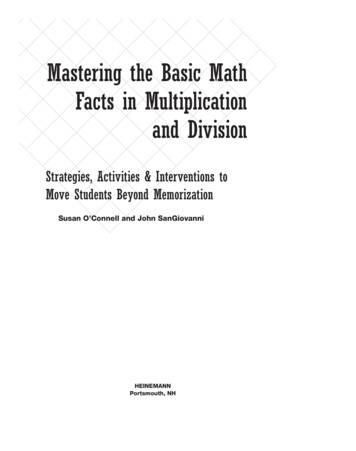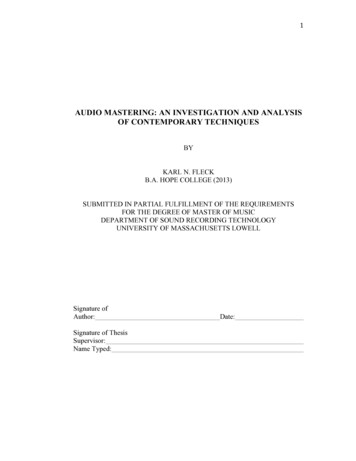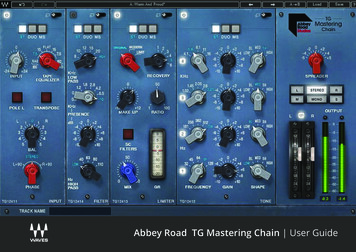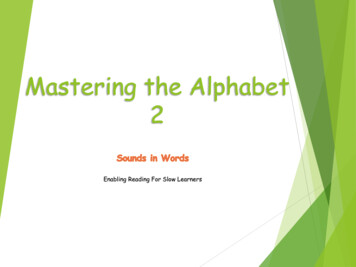
Transcription
Mastering the Basic MathFacts in Multiplicationand DivisionStrategies, Activities & Interventions toMove Students Beyond MemorizationSusan O’Connell and John SanGiovanniHEINEMANNPortsmouth, NHRevised book.indb 12/19/14 1:29 PM
Heinemann361 Hanover StreetPortsmouth, NH 03801–3912www.heinemann.comOffices and agents throughout the world 2011 by Susan O’Connell and John SanGiovanniAll rights reserved. No part of this book may be reproduced in any form or byany electronic or mechanical means, including information storage and retrievalsystems, without permission in writing from the publisher, except by a reviewer,who may quote brief passages in a review; and with the exception of reproducibles(identified by the Mastering the Basic Math Facts in Multiplication and Division copyright line), which may be photocopied for classroom use.“Dedicated to Teachers” is a trademark of Greenwood Publishing Group, Inc.Library of Congress Cataloging-in-Publication DataO’Connell, Susan.Mastering the basic math facts in multiplication and division : strategies, activities& interventions to move students beyond memorization / Susan O’Connell andJohn SanGiovanni.p. cm.Includes bibliographical references.ISBN-13: 978-0-325-05965-51. Multiplication—Study and teaching (Elementary). 2. Division—Study andteaching (Elementary). I. SanGiovanni, John. II. Title.QA115 .O3342011372.7’2—dc222010046909This text was previously published under ISBN-13: 978-0-325-02962-7 andISBN-10: 0-325-02962-8.Editors : Victoria Merecki and Katherine BryantProduction: Victoria MereckiCover and interior designs: Palmer Creative GroupComposition: Publishers’ Design and Production Services, Inc.Manufacturing: Steve BernierPrinted in the United States of America on acid-free paper18Revised book.indb 2171615 14VP4 5 6 7 82/19/14 1:29 PM
DedicationTo the little guys, Colin and Liam, with loveS.O.To Krissy, my favorite math teacher and wine connoisseurJ.S.Revised book.indb 32/19/14 1:29 PM
What are basic math facts? 1What constitutes mastery of basic math facts? 2Why memorize math facts? 2Why is it important to understand math facts? 3How can we help students master basic math facts? 5How can this book help you? 6How is this book organized? 7What is the teaching sequence of math facts within this book? 9What downloadable resources are available? 11Resources for Professional Learning Communities 11Our Goal 12Chapter 1Understanding Multiplication and Division13Exploring Big Ideas to Develop Math Fact Strategies 14Introducing the Concepts of Multiplication and Division 16Using Models to Represent Multiplication and Division 21Posing/Writing Problems to Develop an Understanding of Math Facts 24Exploring Multiplication and Division Through Children’s Literature 25Beginning with Understanding 26vRevised book.indb 52/19/14 1:29 PM
Mastering the Basic Math Facts in Multiplication and DivisionChapter 2Multiplying by Two27Focusing on the Big Ideas 28Understanding 2 Facts 29Literature Link: Two of Everything 29Exploring the Facts: A Focus on Pairs 33Supporting All Learners 35Building Automaticity 38Targeted Practice 38Monitoring Progress 40Connecting to Division 41Chapter 3Multiplying by Ten43Focusing on the Big Ideas 44Understanding 10 Facts 45Literature Link: The Grouchy Ladybug 45Exploring the Facts: Looking for Patterns 47Supporting All Learners 47Building Automaticity 50Targeted Practice 50Monitoring Progress: More on Fact Checks 51Connecting to Division 52Chapter 4Multiplying by Five55Focusing on the Big Ideas 56Understanding 5 Facts 57viRevised book.indb 62/19/14 1:29 PM
ContentsExploring the Facts: An Investigation with Pennies 57Literature Link: Count on Pablo 59Supporting All Learners 62Building Automaticity 64Targeted Practice 64Monitoring Progress: Working Toward Automaticity 65Connecting to Division 66Chapter 5Multiplying by One69Focusing on the Big Ideas 70Understanding 1 Facts 70Literature Link: One Tiny Turtle 70Exploring the Facts: Using Color Tiles 72Supporting All Learners 72Building Automaticity 75Targeted Practice 75Monitoring Progress: Teacher-Administered Individual Fact Checks 76Connecting to Division 77Chapter 6Multiplying by Zero79Focusing on the Big Ideas 80Understanding 0 Facts 80Exploring the Facts: Problem Solving About School Supplies 80Literature Link: Where the Wild Things Are 82Supporting All Learners 83viiRevised book.indb 72/19/14 1:29 PM
Mastering the Basic Math Facts in Multiplication and DivisionBuilding Automaticity 86Targeted Practice 86Monitoring Progress: Charting Foundation Facts 87Connecting to Division 88Chapter 7Multiplying by Three91Focusing on the Big Ideas 92Understanding 3 Facts 92Literature Link: A Three Hat Day 92Exploring the Facts: Doubling and Tripling Baskets of Fruit 95Supporting All Learners 96Building Automaticity 98Targeted Practice 98Monitoring Progress: Individual Student Conferences 99Connecting to Division 100Chapter 8Multiplying by Four103Focusing on the Big Ideas 104Understanding 4 Facts 105Literature Link: If You Hopped Like a Frog 105Exploring the Facts: Visualizing Patterns on a 1–40 Chart 107Supporting All Learners 108Building Automaticity 110Targeted Practice 110Monitoring Progress: Progress Graphs 111Connecting to Division 113viiiRevised book.indb 82/19/14 1:29 PM
ContentsChapter 9Multiplying by Six115Focusing on the Big Ideas 116Understanding 6 Facts 117Literature Link: Snowflake Bentley 117Exploring the Facts: Examining Polygons 120Supporting All Learners 122Building Automaticity 124Targeted Practice 124Monitoring Progress: Teacher Observation 126Connecting to Division 127Chapter 10Multiplying by Nine129Focusing on the Big Ideas 130Understanding 9 Facts 131Literature Link: Cloudy with a Chance of Meatballs 131Exploring the Facts: Observing Patterns 132Supporting All Learners 135Building Automaticity 137Targeted Practice 137Monitoring Progress: Writing About Learning Math Facts 138Connecting to Division 139Chapter 11Multiplying by Eight141Focusing on the Big Ideas 142Understanding 8 Facts 143Literature Link: Snowmen at Night 143ixRevised book.indb 92/19/14 1:29 PM
Mastering the Basic Math Facts in Multiplication and DivisionExploring the Facts: Visualizing Doubles 145Supporting All Learners 145Building Automaticity 147Targeted Practice 147Monitoring Progress: Dealing with Anxiety 148Connecting to Division 149Chapter 12Multiplying by Seven151Focusing on the Big Ideas 152Understanding 7 Facts 153Literature Link: Thunder Cake 153Exploring the Facts: Square Numbers 154Supporting All Learners 156Building Automaticity 156Targeted Practice 156Monitoring Progress: Observing Fact Checks 158Connecting to Division 158Conclusion161References163Professional References 163Children’s Literature 163Professional Learning Communities Study Guide165Guiding Questions 167xRevised book.indb 102/19/14 1:29 PM
ContentsA Guide to the Downloadable ResourcesOrganization of the Files173173Teaching Resources173Teaching Tools173Fact Cards173Assessment Tools173Modifications to Activities174Throughout this book, the Downloadable Resourcesare indicated by DR.How to Access the Downloadable ResourcesStep 1: Go to www.heinemann.com.Step 2: Click on “Login” to open or create your account. Enteryour email address andpassword or click “Register” to set up an account.Step 3: Enter keycode MTBMFMD and click “Register.”xi
ForewordBeing able to add and subtract within 20 and multiply and divide within 100is essential during the early years of schooling, and the basic facts of addition/subtraction and multiplication/division are a critical baseline, not only thenbut also during later work with fractions, decimals, ratio, proportion, andmore. Foundational? You better believe it. Essential? Absolutely.That said, the basic facts are also problematic. The goal is for most students to know, fluently, and with automaticity, the addition/subtraction facts,typically by the end of second grade and the multiplication/division facts, typically by the end of third grade. But far too many teachers are unable to helptheir students reach these goals. “Not this year,” they may mutter, or, “Not allmy students,” or worse, “Not ever.” Why is fluency with the basic facts sucha challenge for so many students? In our digit-conscious culture students canspout off multiple phone and pin numbers, but not the product of 6 7! I meetand work with middle school students who are still wondering about 8 7 or48 6 and other basic facts. Why do far too many students fail to realize thatthe commutative property means that 9 7 and 7 9 get you to the sameplace, 16? This drives us all crazy! Have we neglected the basics? Is this aboutjust having students memorize the facts? No, and no!Over twenty years ago the Curriculum and Evaluation Standards for SchoolMathematics noted that “children should master the basic facts of arithmeticthat are essential components of fluency with paper-pencil and mental computation and with estimation” (47).1 The National Research Council’s AddingIt Up dedicates almost ten pages to synthesizing the research dealing withbasic fact acquisition.2 More recently, the Final Report of the National Mathematics Advisory Panel points out that computational proficiency with wholenumber operations depends on the practice (I prefer the term rehearsal) necessary to develop automatic recall of addition/subtraction and multiplication/division facts.3 Nurturing computational facility in elementary school requiresthat students be fluent with the basic facts of arithmetic. How do we get thisdone?Over the years teachers have tried and continue to use a myriad of practiceactivities—oral and written exercises, games, and classroom and homework1National Council of Teachers of Mathematics. 1989. Curriculum and Evaluation Standards for School Mathematics.Reston, VA: National Council of Teachers of Mathematics.2National Research Council. 2001. Adding It Up: Helping Children Learn Mathematics. Washington, DC: NationalAcademy Press.3National Mathematics Advisory Panel. 2008. Foundations for Success: The Final Report of the National MathematicsAdvisory Panel. Washington, DC: U.S. Department of Education.xiiiRevised book.indb 132/19/14 1:29 PM
Mastering the Basic Math Facts in Multiplication and Divisionassignments, many of them now via the Internet. At last we have a more effective option—Susan O’Connell and John SanGiovanni’s Mastering the Basic Factsin Addition and Subtraction: Strategies, Activities & Interventions to Move StudentsBeyond Memorization and Mastering the Basic Facts in Multiplication and Division:Strategies, Activities & Interventions to Move Students Beyond Memorization. Whata find!Based on Thornton’s pioneering work4 emphasizing how thinking strategies facilitate fact acquisition, both books present activities that develop facility with the basic facts by building a conceptual understanding of the operations; following a teaching sequence designed to develop a sense of numberusing fact strategies and the commutative property; and using representational models and context-based problem solving. (The activities that link factsto their conceptual representations are also powerful diagnostic tools.) Butthere’s more—related children’s literature, partner activities, a professionallearning-community study guide. All these components add up to resourcesthat engage students, from beginning activities that promote an understanding of arithmetic concepts, through fluency with the basic facts.One final consideration: these books will be very helpful to teacherswhose students’ mathematical knowledge require some level of intervention.The powerful instructional opportunities these books provide not only makesense but also meet one of the key recommendations of the What Works Clearinghouse’s Practice Guide Assisting Students Struggling with Mathematics.5These books won’t end up on a shelf at the back of your room. (And if youare a third/fourth-grade teacher you will probably need both of them.) You’lluse them every day. You’ll carry them home with you and talk about them inthe faculty lounge. Just as the basic facts are “must haves” on the path to computational fluency, these books are “must haves” to help you navigate the route.Francis (Skip) FennellL. Stanley Bowlsbey Professor of Education & Graduate and Professional StudiesMcDaniel College, Westminster, MDPast President, National Council of Teachers of MathematicsProject Director, Elementary Mathematics Specialists and Teacher Leaders Projecthttp://mathspecialists.org4 Thornton, C.A. 1978. “Emphasizing Thinking Strategies in Basic Fact Instruction.” Journal for Research in Mathematics Education. 16: 337–355.5 Gersten et al. 2009. Assisting Students Struggling with Mathematics: Response to Intervention (RtI) for Elementary andMiddle Schools. Washington, DC: Institute of Education Sciences.xivRevised book.indb 142/19/14 1:29 PM
AcknowledgmentsMany thanks to the students whose conversations about math facts inspiredand excited us as we worked on this manuscript. Thanks to the followingstudents who contributed work samples or allowed their photographs toappear within this book: Stephen Alam, Chiagozie Anyanwu, Yomi Bashorum, Joshua Baumbgardner, Julia Bonner, Cameron Brickner, Jack Cartee,Austin Cestone, Ryan Davis, Amilli Diaz, Nolan Dyer, Gabrielle Eng, RickyFedorchak, Brianna Galt, Jaylin Harding, Maura Hill, Yevin Hong, ColbyJardim, Caitlyn Kealy, Amira Kim, Andrew Kim, Rachel Kim, Sumin Kim,Jillian Lach, Erin Ko, Lanae Martin, Samantha Miller, Cortez Mora, DaisheauMorris, Maria Mulroe, Stephanie Owens, Arwin Pare, Keyonna Paul, ChrisPerez, Alli Polinsky, Nittin Raj, Elizabeth Raney, David Rucker, Oscar Schoenfelder, Deryn Schoenfelder, Alyssa Souder, Nick Stitely, Ryan Tracey, Caroline Underwood, Grace Underwood, Emma Vittori, Paul Weatherholtz, andMichaela Wesley. It was a pleasure watching them investigate math facts.We appreciate the collaboration of colleagues in gathering materials forthis book, in particular the following teachers, math coaches, principals,and supervisors who welcomed us into their classrooms, provided insightsfrom their own teaching, or allowed us to listen to the ideas of their students:Randi Blue, Robin Balimtas, Leslie Brickner, Shannon Callihan, Sue Donaldson, Heather Dyer, Julie Eugenio, Carol Hahn, Asha Johnson, Pamela Jones,Sally Kingsley, Olga Lloyde, Sorsha Mulroe, Kathleen Nagle, Dana Polan, KaySammons, and Jennifer Zin.We are grateful to Victoria Merecki, our Heinemann editor, for her guidance from start to finish on this project. In addition, we thank Emily Birch forher vision for this book. Her discussions in the early stages of the book wereinvaluable.Special thanks to our families for their patience and understanding during the writing of this book. To Sue’s husband Pat, and her children Brendanand Katie, and to John’s wife Kristen, and Oscar and Deryn, our warmestthanks for your continued support.xvRevised book.indb 152/19/14 1:29 PM
IntroductionAs math teachers, we want our students to develop a quick recall of singledigit addition, subtraction, multiplication, and division facts. We label thembasic math facts because they provide a foundation for math success. Weexpect that all students will master these basic skills, but that is not a simplegoal to achieve. We watch some students effortlessly remember the facts andothers struggle with the very same task. And we labor to find just the rightstrategies and activities to help all students succeed.As teachers, we are constantly reminded that our students learn in a variety of ways. Although some students have very strong memory skills, othersstruggle to remember simple facts. Although some students make sense ofmath concepts on their own, others struggle to connect meaning to simpleexpressions like 3 5. Although some students intuitively use their knowledge of one math fact to solve a related fact, others simply get frustrated anddiscouraged when they cannot remember a specific sum or product. Our students are so different, and yet our goal for each of them is the same: to master basic math facts so they have a strong foundation for more complex mathskills and procedures. The goal of this book is to explore numerous strategiesand activities that support all students in understanding basic multiplicationand division facts and committing those facts to memory. Whether you areintroducing students to basic math facts, reviewing previously taught facts, orproviding interventions for students who continue to struggle, this book supplies you with instructional considerations, practical strategies, and numerous classroom-tested activities.What are basic math facts?For the purpose of this book, basic facts are considered to be facts with factorsof 0–10. In some programs, facts with single-digit factors (0–9) are consideredbasic, but because of the significance of the 10 facts, they are included withinthis book. An understanding of 10 facts provides an important benchmarkfor understanding 5 facts or might suggest a strategy for determining 9facts. The inclusion of 10 facts is based on providing a solid understandingof numbers as the foundation for our study of basic facts.1Revised book.indb 12/19/14 1:29 PM
Mastering the Basic Math Facts in Multiplication and DivisionWhat constitutes mastery ofbasic math facts?In the past, much of mathematics was taught in a drill and practice style. Students were simply asked to memorize their math facts, often without muchattention to conceptual understanding. Through worksheets filled with single-digit computations or lengthy flash card sessions, students were askedto memorize multiplication and division facts. Our goal in today’s math classrooms has shifted from memorizing facts and procedures to increased understanding of math skills and concepts. We want our students to be able to domathematics, but we also want them to understand the math they are doing.We recognize that as math tasks increase in complexity, an understanding offacts, formulas, and algorithms will help them experience continued success.We have not changed our view of the importance of basic math facts. Weknow that they are a foundational skill and that without that skill our students will view even simple math tasks as daunting. We have simply expandedour expectations to include understanding as an important component of ourteaching of basic math facts. So, what do we expect of our students? Our goalis both automaticity and understanding. Automaticity is students’ ability toeffortlessly recall a fact. If students are automatic, they have successfully committed the facts to memory. In addition, we want our students to understand,not simply remember, these important math facts.Why memorize math facts?Ask math teachers what they would like their students to know and be ableto do, and the recall of basic math facts will undoubtedly rank high on mostof their wish lists. Teachers recognize that once their students know 3 5,those students are better able to explore 3 50 or 3 55. Teachers recognizethat students will have an easier time finding the solution to 3 5.00 or 3 .5.These teachers know that their students will be more successful when theyare challenged with –32 –51. As math tasks become more complex, we want ourstudents to possess the foundational skills to be successful.We have gained insights from brain research about demands on the working brain. As students begin to learn math facts, their brains are focused onthose basic computations, but as students become automatic with basic facts,their brains are then able to focus on other aspects of the task like the challenges2Revised book.indb 22/19/14 1:29 PM
Introductionof place value, decimals, or fractions. Being automatic with basic facts frees thebrain to focus on other math processes.Committing basic math facts to memory speeds up math tasks. As mathtasks increase in complexity, they often require multiple steps to find thesolution. Multiplication with three-digit factors and division with decimalsare examples of more complex computational tasks. These tasks are timeconsuming, and often stressful, for students who must stop to figure outeach basic fact along the way. And stopping to determine each fact disruptsthe flow of the math procedure. The National Mathematics Advisory Panel(2008) urges that students develop automatic recall of multiplication andrelated division facts to be prepared for the study of algebra, in which solving multistep equations is a fundamental task.Students who have committed basic math facts to memory are able toperform critical mental math tasks. They estimate answers prior to solvingproblems so they are able to compare their estimates to the actual answersand determine the reasonableness of their solutions. When browsing througha grocery store, students with mental math skills can determine the approximate cost of buying 4 bags of pretzels if each bag costs about 3.00, or whencounting the savings in their piggy banks, they can quickly determine thattheir 9 nickels amount to 45 cents in savings. As students determine how tofairly share 36 cookies among 9 friends, they can automatically determine thequantity each child will receive. Mastery of basic facts provides the foundation for everyday mental math tasks.Automaticity means the quick and effortless recall of math facts. No needto count every object. No need to think about related facts. No need to extendpatterns. The answer is automatically known. Although automaticity is a goalfor our students, alone it is not enough. Students must first understand thefacts that they are being asked to memorize.Why is it important to understandmath facts?During the memorization process, students are supported by an understanding of what they are being asked to memorize. Memorizing a chain of nonsensical words (e.g., sat chair red girl a in little the) is more difficult than memorizing a sentence in which the words have a meaning (e.g., A little girl sat in the redchair.). Asking students to memorize dozens of number facts can be discouraging and confusing when students view them simply as pairs of numbers. The3Revised book.indb 32/19/14 1:29 PM
Mastering the Basic Math Facts in Multiplication and Divisionunderstanding that 7 3 represents 7 groups of 3 items aids the memorizationprocess.Students who rely solely on the memorization of math facts often confuse similar facts. Consider the multiplication facts 9 5 45 and 9 6 54.The products are commonly confused by students who have only memorizedanswers. Students often mix up the products and respond mistakenly that 9 5 54; however, for students who have explored an understanding of multiplication, 9 5 54 just doesn’t make sense: 10 5 50, so how could 9 5 54? The product has to be less than 50! A focus on understanding multiplication and division facts will provide students with a firm foundation ratherthan simply relying on memory.Students who simply memorize math facts miss a prime opportunity toexpand their understanding of equations. Problem solving is the central focusin today’s math classrooms. To be a successful problem solver, students mustbe able to accurately compute answers, but more than that, they must be ableto figure out how to build equations that correspond to problem situations.Colin was stacking books on the shelves of his brand-new bookcase. Heput 7 books on each of the 4 shelves. How many books did he put on theshelves of his bookcase?This problem certainly requires the student to know that 4 7 28, but evenbefore the student can use his knowledge of math facts to find the answer,he must understand how to build an equation that works with this problem.There are 4 shelves and each shelf has 7 books on it. Since each shelf has thesame number of books, I can multiply. 4 groups of 7 or 4 7 is how I find theanswer!As we discuss the connection between the meaning of the equation and thebasic math fact, we are supporting both students’ computation skills as wellas building a strong foundation for problem solving.Both the Common Core State Standards (National Governors Association Center for Best Practices and Council of Chief State School Officers 2010) and theNational Council of Teachers of Mathematics’ Principles and Standards (2000)emphasize the importance of students understanding the concepts of multiplication and division. The Common Core State Standards recommend that secondgraders be given opportunities to explore problems with equal-sized groups ofobjects to build a foundation for multiplication. Third-grade students then continue to explore the concepts, work with properties of operations, and apply4Revised book.indb 42/19/14 1:29 PM
Introductiontheir understanding of numbers and properties to develop effective strategiesfor multiplying and dividing. Understanding is developed first, with practicefor fluency coming later.How can we help students master basicmath facts?We expect that our students will quickly recall facts without the need formanipulatives or number strategies. Although memorization is a part of theprocess, we recognize that students benefit from varied opportunities toexplore basic math facts before being asked to memorize them. An instructional approach in which students investigate the meaning of facts throughhands-on activities and thoughtful discussions, explore strategies to supporttheir understanding of numbers, and then engage in strategic practice tomemorize the facts provides students with a strong and balanced foundationfor mastery.Understanding operations is fundamental to understanding math facts.Students develop deeper understanding of operations through problem posing, hands-on explorations, real-world examples, classroom discussions, andexploring situations from children’s literature. Division scenarios that showfair sharing and multiplication stories that demonstrate combining equalgroups help students strengthen their understanding of operations, and students who understand operations will find that math facts make sense.There are many ways that students might arrive at an answer to a mathfact. When multiplying 4 3, Bailey might count every object in the 4 groupsof 3 to find the total, and Liam might simply remember that 4 3 12. Mathfact strategies lie somewhere between counting each object and simply memorizing the answer. They are predictable and efficient ways to find answers.Allison knows that 3 4 12, so 4 3 12, too. Brendan might recognizedoubles—if 2 3 6, then 4 3 is twice that amount or 12—and Katie knowsthat 3 3 9, which is 3 groups of 3, so 4 3 is just 1 more group of 3, whichmeans 12. Strategies help students find an answer even if they forget whatwas memorized. Discussing math fact strategies focuses attention on numbersense, operations, patterns, properties, and other critical number concepts.These big ideas related to numbers provide a strong foundation for the strategic reasoning that supports mastering basic math facts. For multiplication anddivision, strategic reasoning related to doubling and halving, the commutative property, zero and ones properties, recognizing patterns, and breaking5Revised book.indb 52/19/14 1:29 PM
Mastering the Basic Math Facts in Multiplication and Divisionnumbers apart to find related products provides students with a solid foundation for mastery of math facts.Once an understanding of operations has been developed and studentshave explored strategic reasoning to find solutions to basic math facts, it is timeto engage students in meaningful practice so they can commit the facts tomemory. Rather than long practice sessions (Remember the lengthy flashcard drills of days past?), consider activities that are short in duration but easyto implement, so students are frequently engaged in valuable practice. Scattered practice—five to ten minutes a day, spread throughout the school year—yields great results. And varying the practice activities so students remainmotivated and engaged is essential to the process. Brief, frequent, interactiveactivities that provide students with repeated exposure to math facts supportautomaticity.Because of the anxiety associated with memorization tasks for many students, the practice tasks in this book do not focus on speed or elimination.Although speed drills or elimination games may be enjoyed by some students,these types of activities often intensify the frustration and anxiety of others. Students who struggle with rote memory tasks, those students who arethe reason we include math fact activities in our daily schedule, are just theones who become discouraged by the speed drills or experience humiliationwhen they are the first to be eliminated. These are the students we want tomotivate—the students we need to engage in repeated practice sessions. Youwill find that many practice activities are presented throughout this book. Itis important to select the ones that work for your students. Although somestudents find competitive activities fun and motivating, others thrive on collegial tasks.How can this book help you?This book is a practical guide for helping students master multiplication anddivision facts. It includes insights into the teaching of basic math facts including a multitude of instructional strategies, teacher tips, and classroom activities designed to help students master their facts. The emphasis is on strengthening students’ understanding of numbers, patterns, and properties as anessential component of math fact teaching. Wh
Mastering the basic math facts in multiplication and division : strategies, activities & interventions to move students beyond memorization / Susan O’Connell and John SanGiovanni. p. cm. Includes bibliographical references. ISBN-13: 978-0-325-05965-5 1. Multiplication—Study and










